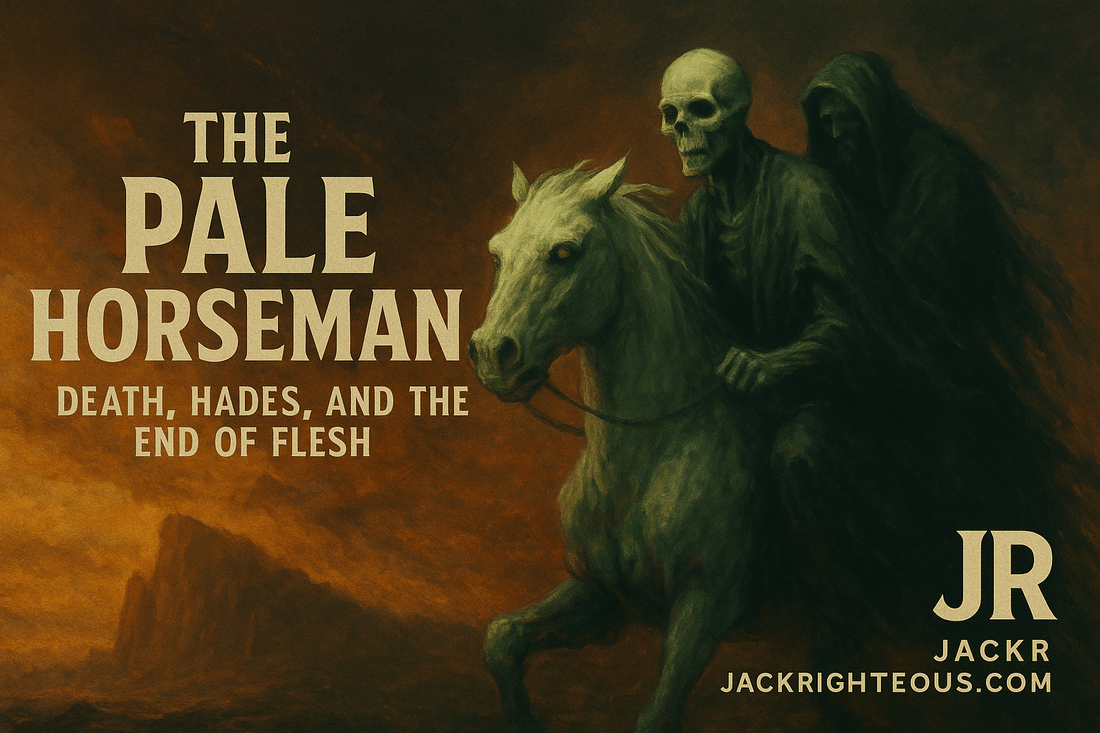
Pale Horseman: Death, Hades, and Final Judgment
Gary WhittakerThe Pale Horseman – Death, Hades, and the End of Flesh
🔥 Soundtrack to Prophecy: Listen While You Read
This article pairs with my AI-crafted apocalypse anthem "Fire Pon Rome" — a militant prophecy about judgment, collapse, and the fall of Babylon.
🎧 Spotify: Fire Pon Rome
🎥 YouTube Video: Watch Here
📜 Read Full Lyrics: Suno Link
“Scroll dem close — di wicked undone / Zion rise — di battle won”
— Fire Pon Rome
The fourth seal opens—and out comes the final rider. He’s not as dramatic as war or conquest. He’s not as deceptive as famine. He’s the last word.
His name is Death. And he rides a pale horse.
But he’s not alone. Hades follows behind.
This isn’t just about dying. It’s about what comes next.
📖 Revelation 6:7–8 – Death Rides Out
“When the Lamb opened the fourth seal... I looked, and behold, a pale horse! And its rider’s name was Death, and Hades followed him. And they were given authority over a fourth of the earth, to kill with sword and with famine and with pestilence and by wild beasts of the earth.”
— Revelation 6:7–8 (ESV)
🔍 Breaking Down the Symbols
🟢 The Color Pale (Greek: Chlōros)
- Not pale white — chlōros means greenish, sickly, or decaying
- Used elsewhere for grass or disease-colored flesh
- The color alone signals plague, rot, and death
💀 The Rider: Death
- The only rider given a name
- Represents physical death in all its forms — war, hunger, disease
- He doesn’t cause death — he is death
Hades Follows
- Hades is the realm of the dead (not hellfire, but the grave)
- It’s where the dead go before final judgment
- This pairing shows death is not the end — it’s a passage
The Scope of Their Power
“Given authority over a fourth of the earth...”
The first three riders set the stage — this one collects the result.
- Sword = violence and war
- Famine = hunger and poverty
- Pestilence = disease and plague
- Wild beasts = loss of dominion over nature
This is a full breakdown of human power. The curse is complete.
Interpretations of the Pale Horseman
- 1. Literal Death and End-Time Plagues
- Seen as a wave of death during the tribulation
- Could involve pandemics, biowarfare, or ecosystem collapse
- Follows the collapse from conquest, war, and famine
- 2. Spiritual Judgment and Finality
- Symbol of the wages of sin (Romans 6:23)
- His presence is both natural and spiritual
- Reminds us of the temporary nature of flesh
- 3. The Final Stage of Human Collapse
- Death follows when all systems fail: government, economy, health, nature
- Hades shows that death without God is not the end — it’s captivity
Why This Rider Still Matters
- The Pale Horseman is inevitable. He’s a mirror we all face.
- He doesn’t ask permission
- He doesn’t discriminate
- He reminds us: life is temporary — but judgment is not
- The question is never if he rides. It’s whether we’re ready when he does.
Reflect and Respond
“Trumpets sound — no place fi run / Chains break loose when di work get done”
— Fire Pon Rome
🎧 Let this track echo what Revelation reveals. Listen now:
💬 Comment below — What does this rider awaken in you? Fear? Reflection? Resolve?
Want to Create Your Own Prophetic Track?
No studio. No gatekeepers. Just your voice and divine fire.
- ✅ Use Suno AI for Free – My Invite Link
- ✅ Download the Free AI Music Starter Kit
- ✅ Write with the JR Righteous Lyrics Lab GPT
🔥 Death rides. But so do we. With purpose. With prophecy. With fire.
🔍 Explore the Full Series: Decoding the Four Horsemen of the Apocalypse
This article is part of a complete 7-part series examining the symbols, scriptures, and deeper meaning behind the Four Horsemen of the Apocalypse and their origins.
📖 Read all parts of the series:
- 👉 Four Horsemen: Symbols, Colors, and Meaning
- 👉 The White Horseman – Christ or Antichrist?
- 👉 The Red Horseman – War and Division
- 👉 The Black Horseman – Famine and Injustice
- 👉 The Pale Horseman – Death and Hades
- 👉 Who Wrote Revelation and Why It Matters
- 👉 Other Apocalyptic Riders and Beasts in Prophecy
Related Series:
👉 Trump Evangelicals vs. Biblical Christianity
Ready to Launch or Level Up Your AI Music Journey?
🔹 Start Here – The Suno AI Creator Guide:
https://jackrighteous.com/pages/suno-guide-getting-started
🔹 Learn to Brand with Sound – GET JACKED Into Suno Branding:
https://jackrighteous.com/pages/start-ai-music-branding
🔹 Unlock the Full Anthem Path – GET RIGHTEOUS System Access:
https://jackrighteous.com/pages/get-righteous-anthem-guide
(Requires one of the following:
– https://jackrighteous.com/products/get-jacked-full-pro-kit
– https://jackrighteous.com/products/get-jacked-pro-ai-music-kit
– https://jackrighteous.com/products/sanctuary-digital-download-support-the-album-build)

